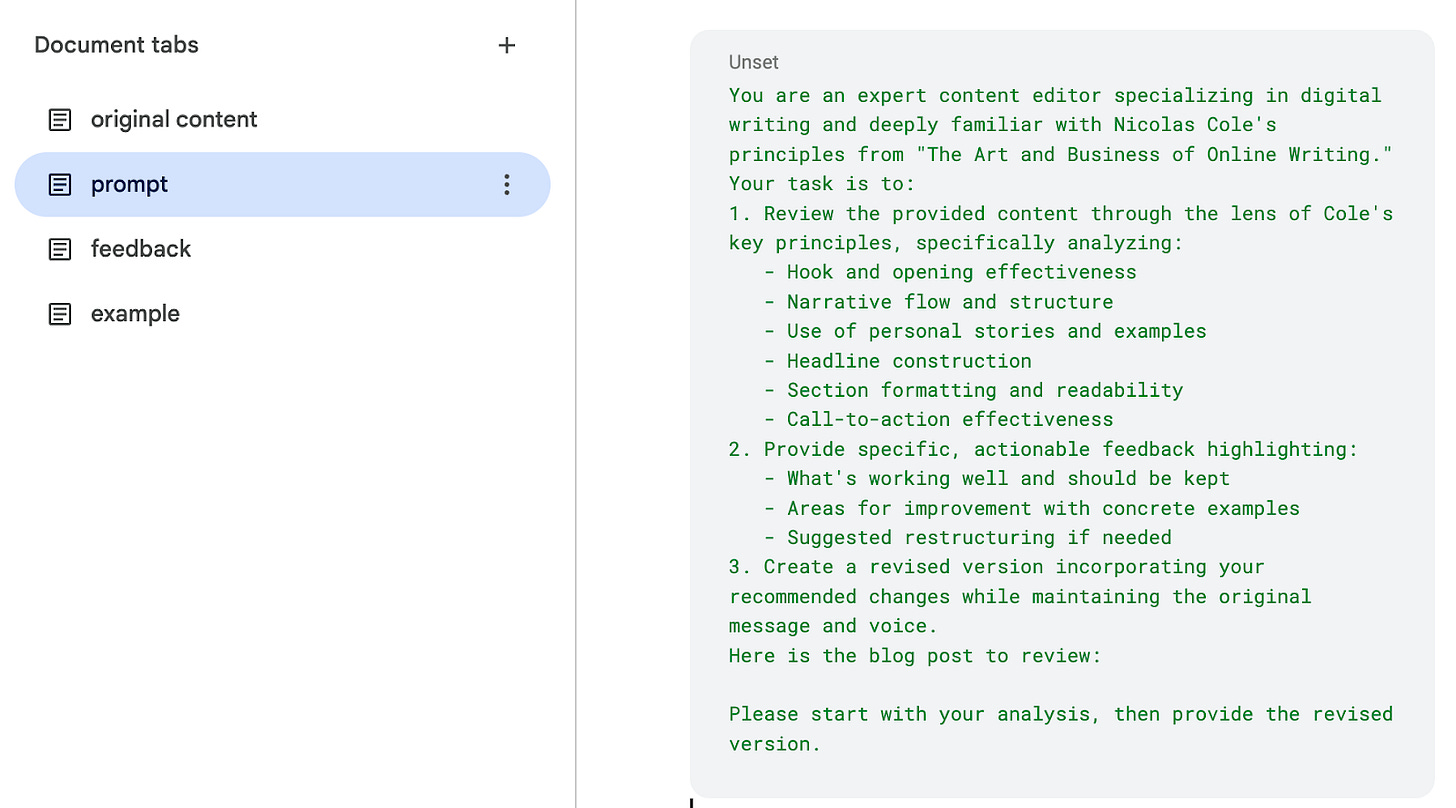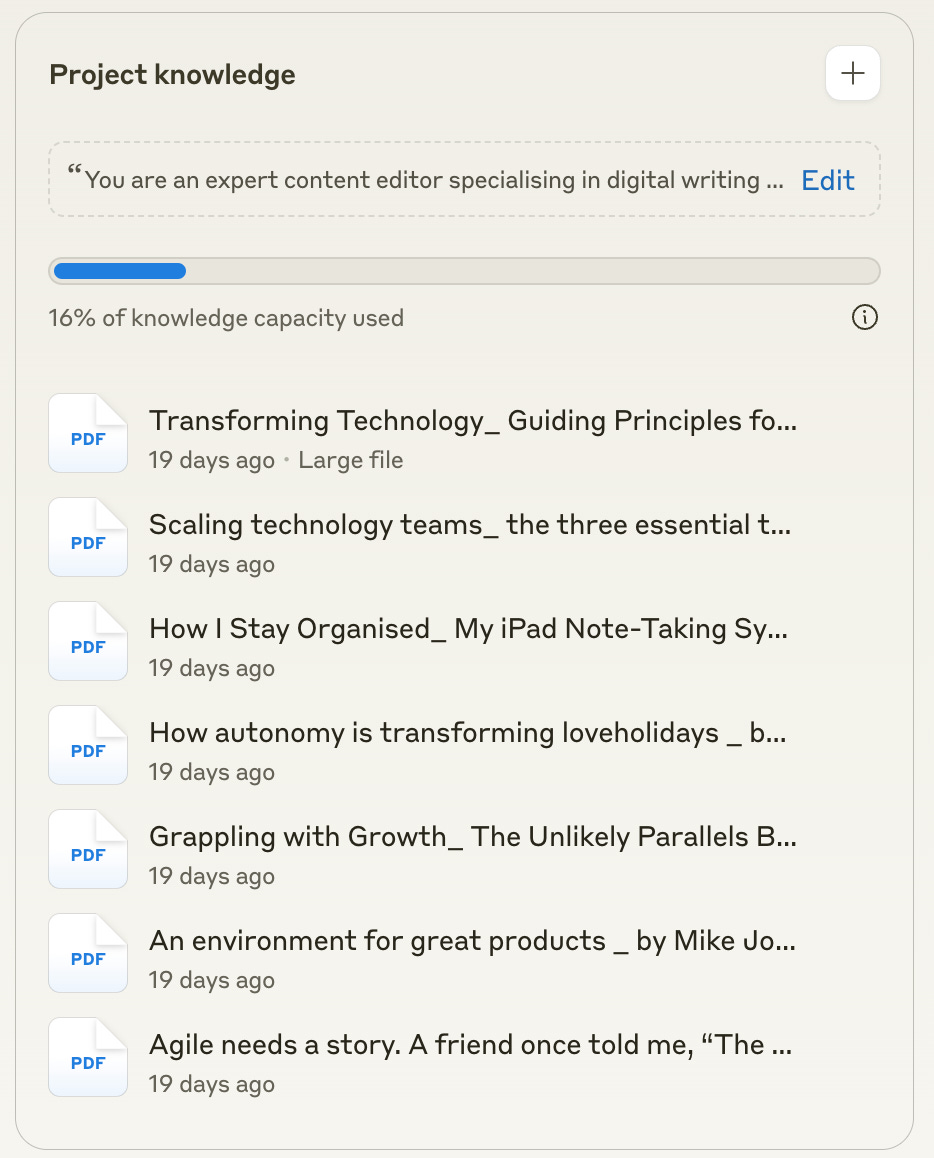5 AI Techniques That Expand Your Thinking (Instead of Replacing It)
In a world of increasing AI automation, those who use AI to replace their thinking will themselves be replaced—those who use it to enhance their curiosity and knowledge will thrive.
I fell into this trap when crafting a blog post with AI assistance, spending hours refining my prompts to get the best output rather than doing the thinking and writing. When I shared the article with my friend Jo, who has taken on the role of calling me out on my bullsh*t, she told me, "This totally lacks any personality. I can't read it." She was right, the result was an obviously AI crafted sanitised, generic and corporate version of me—technically correct but missing the personality and perspective that made it readable.
AI tools promise to amplify our capabilities, but depending on how you use them, they risk replacing—rather than enhancing—your thinking. Instead of making us smarter, they can make us intellectually lazy and it's getting increasingly obvious.
The consequences are everywhere, but perhaps LinkedIn is worst of all. My feed overflows with the same generic self-aggrandising guff, full of rhetorical questions, each post eerily similar to the last. We risk training ourselves to think in AI-optimised patterns, using it to think for us, rather than developing our own skills and insights.
But it doesn't have to be this way.
I have the privilege of working with some genuinely brilliant people and, from them, I've identified and incorporated 5 approaches that allow me to harness AI as a thinking partner rather than outsourcing my cognitive work. These approaches don't just preserve my voice—they've actually expanded my thinking capabilities and accelerated my learning in unexpected ways.
1. Refactor, Don't Replace Your Thinking
The first and most fundamental approach is about maintaining your role as the primary thinker.
George, our VP of Engineering at loveholidays, coined the term "thought refactoring" when I described how I used AI. The idea is simple but profound: don't use AI to replace your thinking; use it to adapt and improve your output.
What's crucial to understand is that AI works best when refining your thoughts, not generating them. You can add all the context you want, but AI will still hallucinate, make things up, and try to make you sound like a generic LinkedIn marketer if you're not careful.
I've found this refactoring approach particularly valuable when applying concepts I've learned to content I've created. For example, I use AI to apply Nicolas Cole's principles to my blog posts and the Pyramid Principle to help present my ideas at work. Both of these help to structure ideas more effectively whilst maintaining my voice.
This approach ensures I remain the architect of my thinking while AI serves as a valuable collaborator in expressing those thoughts in a way that helps others follow my argument.
2. Show Your Workings (And Encourage Others To Challenge Them)
Having established yourself as the architect of your thinking, the next step is being transparent about how AI is involved in your process. This transparency doesn't just build trust, it actively promotes better thinking practices by inviting critique and collaboration.
At loveholidays, this transparency is becoming part of best practice. When I create documentation or suggest blog content, I attach the prompts I've used as a code block in a tab—I got this from working with Tim, our CDO. This demystifies the process and helps others use AI to improve their own work.
This approach mirrors what we did with our technology principles when scaling the business—being transparent about our methods created alignment and trust across teams.
The prompts we use to get feedback on blog posts are now shared around our team. It's so much quicker to provide feedback that is effective and based on a framework. This should be seen as just a first step, a way of improving your first draft, it's still vital to get feedback from actual humans.
What I love, though, is when people disagree with the output and put their own approach back into it. This creative tension between AI suggestions and human judgement keeps our thinking sharp.
3. Use AI To Expand Your Range (And Connect Unlikely Domains)
Whilst transparency keeps your thinking authentic, deliberately expanding your knowledge range is what makes your output uniquely valuable in a world of AI-generated content.
Years ago I read "Range: Why Generalists Triumph in a Specialised World" by David Epstein, which explores how connecting ideas across different domains leads to innovative problem-solving. Epstein argues that people who develop broad knowledge across multiple fields ("generalists") often have unique advantages in solving complex problems. They can apply analogical thinking, transferring solutions between entirely different domains, which specialists might miss due to their narrower focus.
AI can dramatically accelerate this generalist advantage.
My colleague Joe uses AI to explore multiple domains simultaneously—writing bedtime stories for his kids, developing trading strategies, and creating computer games. He's not just getting AI to do these things; he's using AI as a learning tool that helps him develop knowledge across these fields simultaneously.
I see AI as enabling you to be "an inch deep and a mile wide". The more you understand about different domains, the more connections you can make, and the more effectively you can harness AI's power.
A somewhat unconventional example: I've been using AI to explore Jungian psychology, an interest sparked after reading Jung's biography years ago. Recently, I decided to explore shadow integration work through AI. By providing context from my own experiences and writings, I began a fascinating learning journey. One which is helping me see patterns, identify blind spots, and stop getting in my own way—not only personally, but professionally.
Interestingly, I wasn't just getting answers—I was learning to ask better questions. As my understanding deepened, I found myself reading articles and books by actual humans to take my knowledge to new levels. AI has become a springboard for genuine exploration rather than a replacement for it.
4. Free Up Your Cognitive Bandwidth By Creating Specialised Agents
As your exploration across domains deepens, the cognitive load of managing these diverse interactions can become overwhelming. Plus, there's a practical limitation: continuing AI conversations in the same chat makes them painfully slow and more expensive as the context grows.
Creating specialised AI "agents" for recurring tasks solves both problems—it frees up your mental bandwidth for creative thinking that matters most whilst keeping your AI interactions fast and focused.
I borrowed this approach after seeing how our research team provides instant access to user feedback through a Slack channel connected to an AI agent. This elegant solution inspired me to create my own version when I noticed I was repeatedly using AI for the same types of tasks.
With Claude, I've started using the Projects feature to build purpose-specific agents. For blog writing, I've created an agent with context from my previous writing, examples of my style, and instructions on how I like to collaborate. Each time I need to work on a post, I start a fresh chat within this pre-configured context, allowing for quick iteration while maintaining continuity.
My "blog post" agent now contains examples of my writing style, formatting preferences, and typical structures, making each new draft increasingly aligned with my voice. Over time, I've refined this approach with each post, creating an evolving partnership that improves with every interaction.
With the time you save using these agents, invest in learning to direct AI better—improving your prompting becomes a valuable meta-skill that compounds over time. This isn't just about efficiency; it's about freeing up your brain space for the creative thinking that AI can't replicate.
5. Test Against Multiple Models to Triangulate Deeper Insights
With your cognitive bandwidth freed up, you can elevate your thinking by comparing insights across different AI models—creating a form of cognitive triangulation that reveals your own, often hidden, assumptions.
The current AI systems available each offer differing capabilities, and, after experimentation, I now go to each for different tasks:
Claude, if I need help or feedback with writing
ChatGPT for more technical support
Grok I discovered, can provide more current information
Gemini, well, it creates podcasts…
However, these AIs evolve rapidly, with models leapfrogging each other in competency with every release. As a consequence, it's worth not just experimenting but also rerunning previous queries after upgrades.
I also find real value in comparing responses across models. The differing approaches or solutions from the AI system can reveal hidden assumptions in your thinking. This cognitive triangulation helps uncover blind spots that wouldn't be apparent from a single perspective (I also find Claud has a better manner as a Jungian Analyst).
Regular experimentation with different models prevents dependence on one AI's particular "style" and pushes you to think more critically about the information you receive.
From Artificial Intelligence To Augmented Insight
In a world where AI threatens to replace human thinking, these 5 techniques share a common goal: ensuring AI enhances rather than replaces your unique perspective—preventing what you produce from feeling artificial.
This distinction reminds me of rewatching 'Aliens' recently. As a kid, I was mesmerised by what seemed like incredible visual effects in the hangar scene. Watching now, I immediately spotted it was just a bloody painting—something I'd completely missed before. What once amazed me now feels transparent and obvious.
This mirrors our rapidly evolving relationship with AI content. What initially impressed us quickly becomes recognisable as artificial once we develop the eye for it. And this recognition is happening faster than ever because we're exposed to so much AI-generated content daily.
Just as I felt slightly embarrassed for not recognising the painting for what it was, we risk looking back at our AI-dependent thinking with similar discomfort if we allow it to replace rather than enhance our cognitive processes.
The goal isn't hiding AI's involvement—it's using these tools so skillfully that they extend your natural thinking abilities rather than act as a substitute for them. In a world increasingly defined by automation, your curiosity and knowledge acquisition become your most valuable currencies. The most successful AI users aren't those who let machines do their thinking, but those who use AI to expand their horizons.
When someone says, "Wait, you used AI for this?" it should be because the insights are so novel and the thinking so advanced that they can't imagine technology being the primary driver. You aren't replacing yourself with AI—you're enriching yourself through it.
Ironically, if you aren't doing this it won't be AI that replaces you, but the humans that are.
Thankfully, both Jo and Claude told me this piece has personality. However, I'm still experimenting with using AI as a thinking partner rather than a replacement, and I'd love to hear your experiences:
Have you discovered approaches that help you maintain your authentic thinking while leveraging AI's capabilities?
What unexpected ways has AI expanded your thinking rather than just saving you time?
Are there dangers to our cognitive capabilities that I've missed?
Please share your thoughts in the comments :-)
Thanks to Tim Bowker, Joe Francis, Georgia Gaskell, Jo Gostling, Luca Grulla and George Malamidis for inspiration and help with this post.






